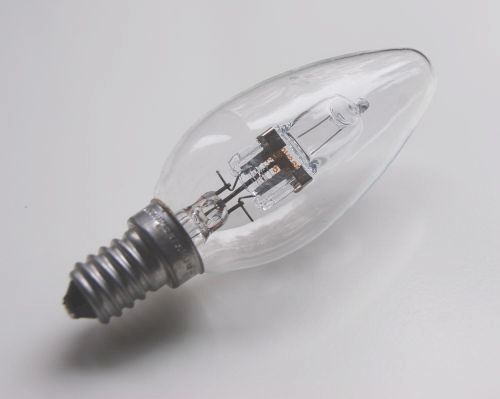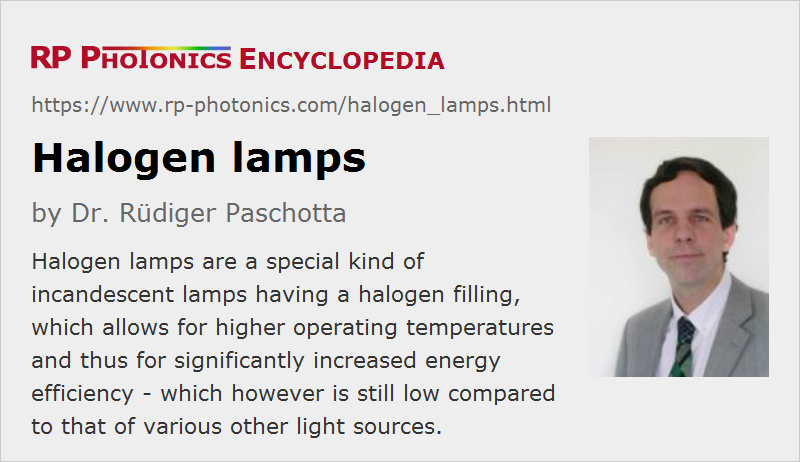Halogen Lamps
Definition: incandescent lamps with a halogen filling, allowing for higher operation temperatures
Alternative term: tungsten halogen lamp
More general term: incandescent lamps
German: Halogenlampen
Category: non-laser light sources
How to cite the article; suggest additional literature
Author: Dr. Rüdiger Paschotta
Halogen lamps are a special type of incandescent lamps, where the bulb is filled with a gas mixture which contains a small amount of a halogen such as iodine or bromine. That gas filling can establish the so-called halogen cycle. The halogen chemically reacts with evaporated tungsten metal from the filament, forming a halide which moves around in the bulb. When it gets close to the hot filament again, it dissociates, and the released metal is deposited on the filament.
In order to avoid deposition of metal on the glass bulb, the bulb needs to become relatively hot during operation; temperatures around 250 °C are appropriate. Therefore, one typically uses relatively small bulbs (with the glass being closer to the hot filament), which are often made of quartz glass (fused silica), because that material can withstand substantially higher temperatures than ordinary bulb glass.
As the filament is typically made of tungsten, as for most other incandescent lamps, the term tungsten halogen lamp is frequently used.
Halogen lamps must not be confused with metal-halide lamps, which are based on a completely different operation principle.
Energy Efficiency of Halogen Lamps
The advantage resulting from the explained halogen cycle is that such a lamp can be operated with a substantially higher filament temperature (around 2900 to 3200 K) while still maintaining a reasonable lifetime and avoiding metal deposition on the glass, which would lead to darkening. Consequences of the increased filament temperature are (a) an increased luminous efficacy, leading to improved energy efficiency, and (b) an increased color temperature, which ironically gives it a “colder” appearance [1], which is closer to daylight. Typical 230-V household halogen lamps with a power consumption of 60 W, for example, reach a luminous efficacy around 16 lm/W. Halogen lamps with the same power but a lower operating voltage of 12 V can range substantially higher luminous efficacies around 20 lm/W, but the difference gets somewhat smaller when considering power losses in the required lamp power supply.
Note that other light sources such as fluorescent lamps and light emitting diodes (LEDs) are still far more efficient than halogen lamps. Therefore, halogen lamps are also gradually phased out, although tentatively later than ordinary incandescent lamps.
Despite the moderate energy efficiency, such lamps can be a good choice for applications where only few operating hours per year are required. The relatively low cost of production is then a more important factor.
Halogen Lamps for Low and High Voltages

As explained above, the highest energy efficiency is achieved with lamps made for low operation voltages such as 12 V. That also has the advantage of avoiding any electric shocks; current-carrying wires may be touched by human beings without the risk. However, one then requires an additional transformer or an electronic device for getting the required low supply voltage from a grid voltage of 230 V or 110 V. That increases the cost, requires additional space and may introduce significant losses of electrical power.
Therefore, halogen lamps have been developed which can be directly used with the grid voltage. Figure 1 shows a lamp for 230 V. It contains a small halogen bulb within a larger glass housing; the latter prevents users from touching the small hot quartz bulb, which could otherwise lead to injuries and to darkening of the glass. It also somewhat reduces the heat losses, but on the other hand it leads to some additional light losses due to parasitic reflections. While such bulbs are a bit more expensive due to their more complicated design, one saves the more substantial cost of additional voltage transformers and profits from the easy installation.
Practical Aspects
A side effect of using quartz glass for the bulb is that some amount of ultraviolet light is transmitted, which would be absorbed by ordinary bulb glass. For a human being spending substantial time next to an unprotected halogen lamp, the UV exposure might lead to sunburn, in the long term even to skin cancer. However, the UV radiation can be blocked with an additional filter glass. That glass can at the same time prevent accidental touching of the hot bulb.
The high surface temperature can cause an increased risk of fire when such bulbs are operated close to materials like wood. There is also a somewhat increased risk of fire associated with transformers and electronics if they are not made with high quality. Note also that the electric currents of arrangements with multiple halogen lamps can be quite high, and high quality electrical connections are then more important.
Unfortunately, there is a relatively wide range of different sockets for halogen bulbs, which makes it more difficult for consumers to find appropriate replacement bulbs. Also, the handling is often more difficult than for E27 or E14 sockets, as used for ordinary incandescent lamps. When exchanging halogen bulbs, one should never touch the glass with fingers, since the deposited fat could later burn in and cause some darkening of the bulb.
Applications of Halogen Lamps
Halogen lamps are often used for lighting (illumination) purposes, particularly where relatively high light output with good color rendering properties is required. For example, outdoor lighting (illuminating buildings, parking spaces, etc.) is often done with such lamps.
While the energy efficiency of halogen lamps is somewhat better than for traditional incandescent lamps, it is still quite poor compared with different types of high pressure gas discharge lamps, such as metal halide lamps, which are also suitable for high power and high intensity illumination. Therefore, for very high-power applications, for example for illuminating sports arenas or large halls, one often prefers metal halide lamps.
For low power lighting, for example in households, halogen lamps are more and more replaced with LED solutions. However, they can still remain a reasonable solution in applications where only few operation hours per year are required, because the lamp cost is relatively low.
Halogen lamps are also widely used for headlamps of cars. They do not perform as well as some more modern solutions such as xenon lamps (which are actually metal halide lamps), except that they reach their brightness much more quickly. However, the cost of halogen lamps is much lower.
In some cases, halogen lamps are used as signal lamps. For example, they may indicate warnings. To a limited extent, they can be used as flashing or pulsating lights, but that may severely compromise their lifetime.
Suppliers
The RP Photonics Buyer's Guide contains 10 suppliers for halogen lamps.
Questions and Comments from Users
Here you can submit questions and comments. As far as they get accepted by the author, they will appear above this paragraph together with the author’s answer. The author will decide on acceptance based on certain criteria. Essentially, the issue must be of sufficiently broad interest.
Please do not enter personal data here; we would otherwise delete it soon. (See also our privacy declaration.) If you wish to receive personal feedback or consultancy from the author, please contact him e.g. via e-mail.
By submitting the information, you give your consent to the potential publication of your inputs on our website according to our rules. (If you later retract your consent, we will delete those inputs.) As your inputs are first reviewed by the author, they may be published with some delay.
Bibliography
| [1] | R. Paschotta, “Cold light from the hottest bodies and from cool devices”, The Photonics Spotlight 2009-10-12 |
See also: incandescent lamps, signal lamps, thermal radiation
and other articles in the category non-laser light sources
 |



If you like this page, please share the link with your friends and colleagues, e.g. via social media:
These sharing buttons are implemented in a privacy-friendly way!